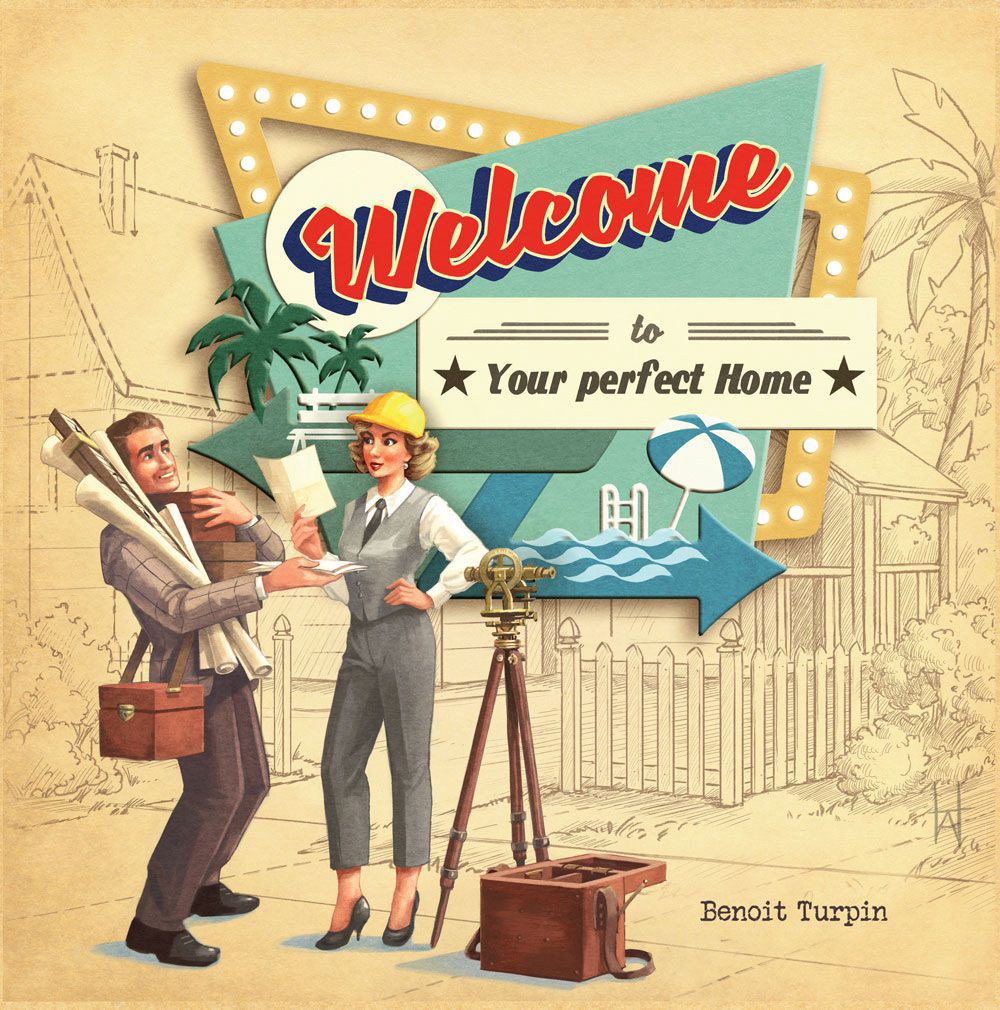Welcome to suburbia! It’s the 1950s, and it’s time to build housing estates for all those baby boomers. Who will earn the title of Best Architect?
What Is Welcome To…?
Welcome To… is a twist on roll-and-write games for 1 to 100 players, ages 10 and up, and takes about 25 minutes to play. Deep Water Games is currently taking pre-orders for a limited print run to be released in June (with optional Origins pickup), followed full release in August at Gen Con. The retail price is $25. It was originally published by Blue Cocker for a European edition.

Welcome To… Components
Note: My review is based on a prototype copy, so it is subject to change and may not reflect final component quality. In particular, this copy used laminated score sheets so they could be reused.
- 29 City Plan cards (18 basic, 10 advanced, 1 Solo)
- 4 Player Aid cards
- 100 Score sheets
- 81 Construction cards
The artwork does a good job evoking the ’50s theme. The construction cards show house numbers on the faces, and the illustrations for each number are unique. It’s important to note that the distribution of the house numbers is in a bell curve: there are numbers from 1 to 15, with 8 being the most common.
Welcome To … is GeekDad Approved!

How to Play Welcome To…
You can download a copy of the rulebook here.
The Goal
The goal of the game is to score the most points by filling in your neighborhood with valuable features and reaching the objectives.
Setup
Give each player a score sheet (and a writing utensil).
Shuffle the construction cards and make three even decks, with the house number face-up.

Shuffle the city plan cards and choose three to display face-up on the table. The city plan cards are each marked with a number 1, 2, or 3—you should have one of each number. For instance, city plans may require you to fill a street, or have a particular set of completed estates, and so on.

Gameplay
Each turn, the top card of each construction deck is flipped over. The face of each card has a house number, and the back of the card has an effect. This creates three sets of house numbers with effects. (You can also see what effects are coming the next round because the effects are shown on the corners of the faces—but you won’t know what house numbers are coming.)

Each turn, every player looks at the three sets of cards and chooses one to use. You write the house number onto a house on your scoresheet, and then you may also use the effect. You must fill in house numbers in increasing order within each street, with no duplicates, and you may only fill in empty houses that don’t already have a number. If you can’t use any of the numbers at all, you must check off a building permit refusal on your scoresheet—three refusals, and the game is over (and you’ll lose points!).

There are various effects to note:
- Parks let you add a park to the street you just added a number to, and increase the value of that street
- Pools can be circled if you put that number in a house that has a pool, and increase your score.
- Temp Agency (the barricade) allows you to add or subtract up to 2 from the number before filling it in—and players will score based on using the most temp agency effects.
- The fence icon allows you to build a fence between two houses, which divides the streets into estates of various sizes.
- Real Estate Agents will increase the value of estates, the fenced-off areas, as long as every house in the estate has a number.
- Bis (which is from a French term for duplicating address numbers) lets you repeat a number, but will cost you points. You also can’t separate duplicated numbers with a fence (so I cheated in my picture above).
If you’re the first to complete a city plan, you score the larger value and write it on your score sheet, and then the card is flipped over to show only the lower value. Any number of players may score the higher value if they also complete the same objective on the same turn. Thereafter, any players who achieve the same city plan will score the lower value.
Game End
The game ends when any player has completed all three city plans, or has used three building permit refusals, or has built all of their houses on their score sheet. Add up all of your points, subtract your penalties, and the highest score wins! Ties are broken by number of completed estates.

Why You Should Play Welcome To…
I had the chance last week to play a print-and-play copy with Tiffany Caires of Deep Water Games, so although I’ve only gotten to play it once, I enjoyed it enough that I wanted to share the pre-order opportunity!
There’s a growing genre of games often called “roll and write,” where players roll dice and then use the results to fill in a scoresheet of some sort. Qwixx is one such game from Gamewright that I mentioned several years ago, but there’s been a resurgence recently, with many titles I haven’t tried yet. Welcome To… isn’t exactly a “roll and write” because there are no dice involved, but it has a similar idea.
It reminds me most of 20 Express, another quick game that can accommodate any number of players at once, because everyone plays simultaneously. I described 20 Express in my review as “strategic bingo” because you draw tiles out of a bag but everyone gets to fill in those numbers in their own sheet. Welcome To… has the same feel, because you have to write the house numbers in increasing order. But it also adds in some new layers: for one, there are three numbers to choose from, so it’s not just about finding a slot for the number but also deciding which number to take. For another, the effects give you other opportunities to score (or lose) points.
All of these add up to some really fun choices as you plan out your perfect neighborhood. While it has the feel of 20 Express, it is definitely deeper, with more flexibility that allows you to make more strategic decisions rather than just gambling on the odds of a particular number coming up.
The current pre-order is a very limited run, for those who just gotta get their hands on it right away. It’s more or less a direct reprint, with only a few minor changes made to the version published by Blue Cocker Games. If you’re willing to wait until August, Welcome To… will go into wider release at that time, and may benefit from a version 2.1 of the rulebook. But if you’re headed to Origins and want to pick up there, or you just want to get started right away, visit the Deep Water Games site to place a pre-order soon!
Click here to see all our tabletop game reviews.
If you’d like to stay up-to-date with all of our tabletop gaming coverage, please copy this link and add it to your RSS reader.
Disclosure: GeekDad received a copy of this game for review purposes.







